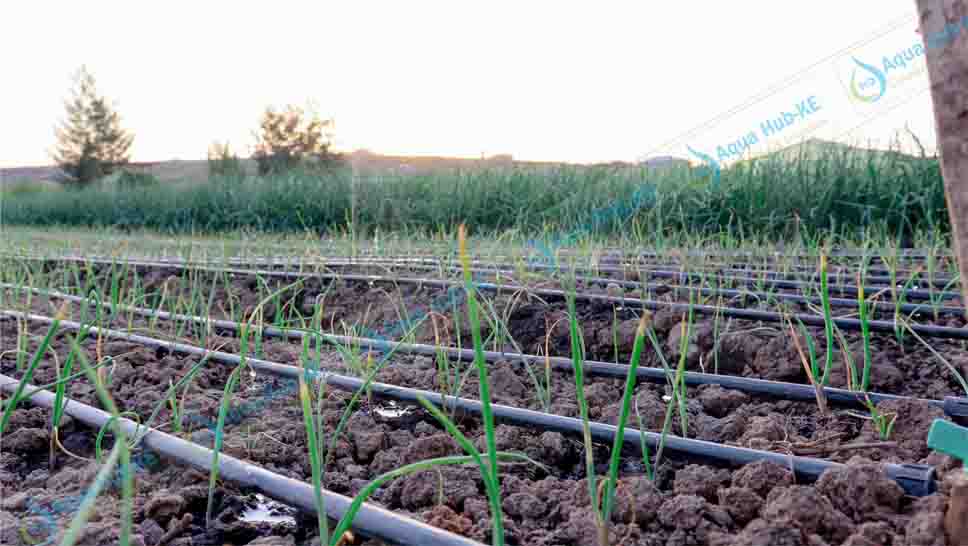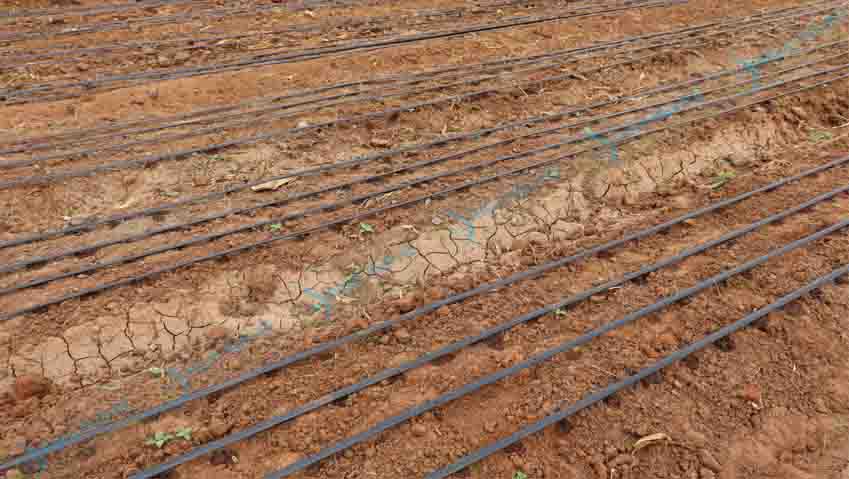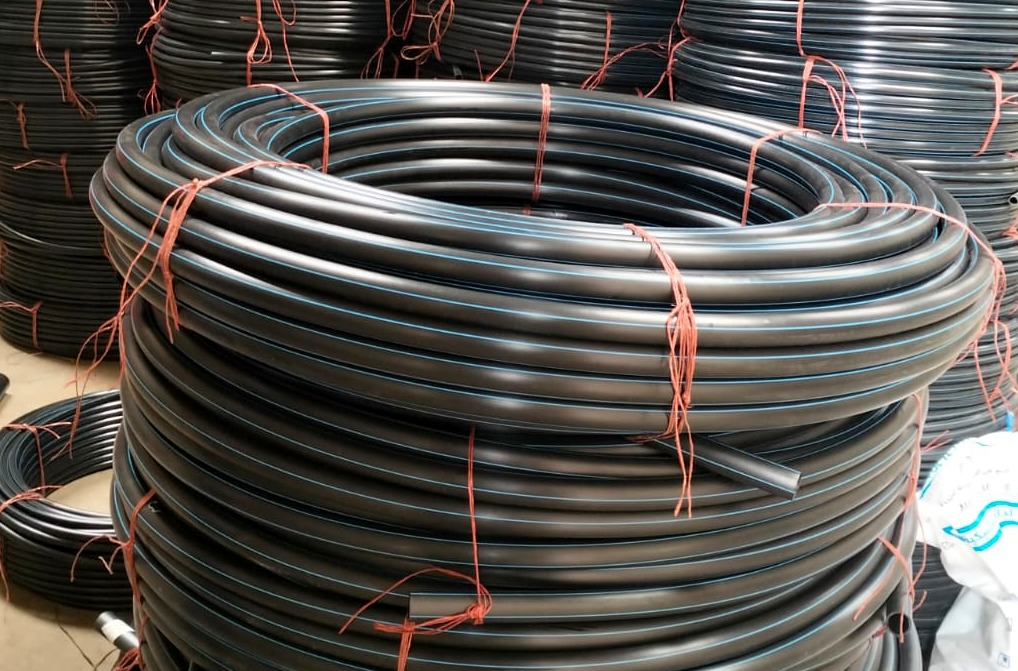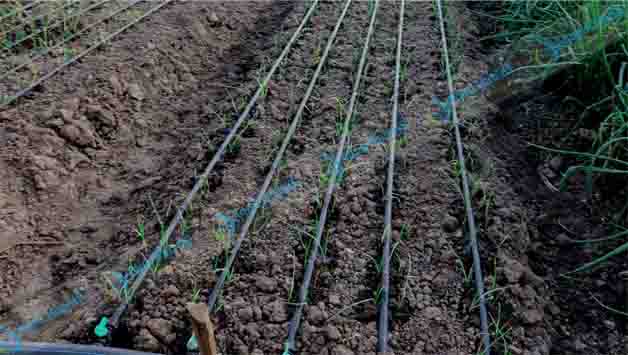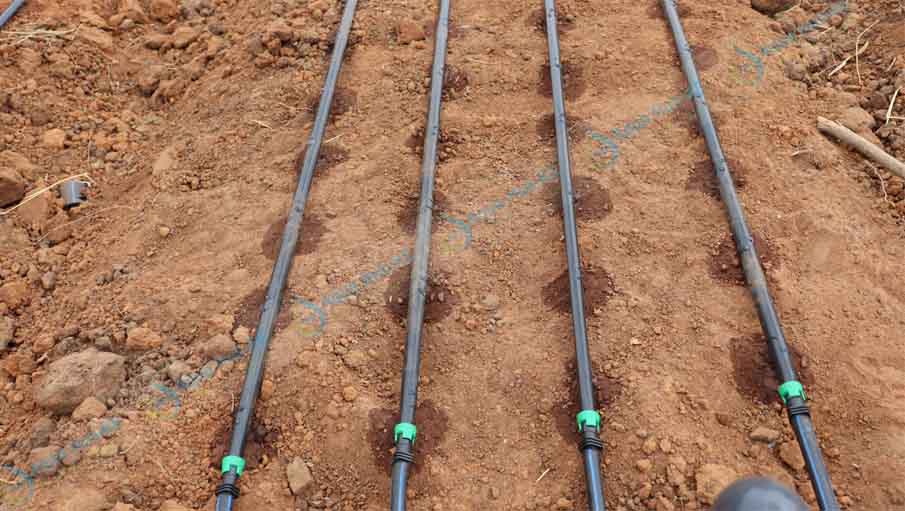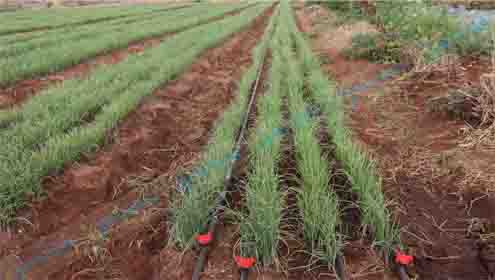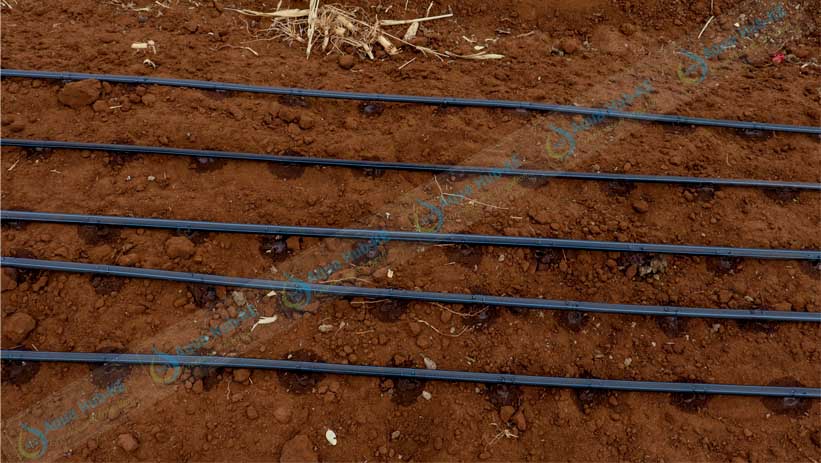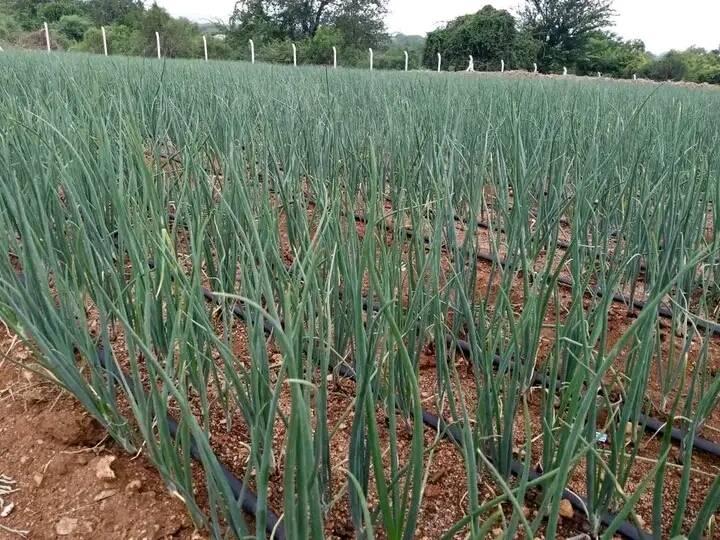Blog
Drip Irrigation for Onion Farming in Kenya
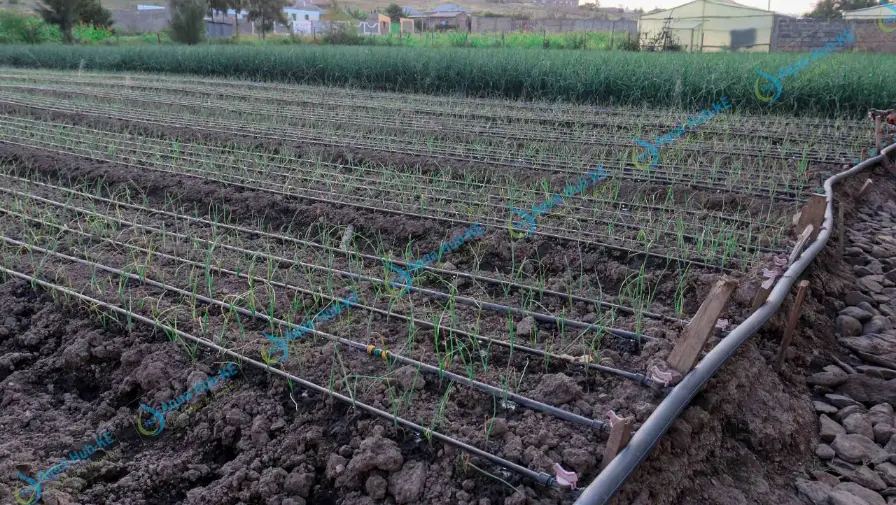
Drip irrigation for onion farming in Kenya saves water while improving production and profit returns.
With the country importing about 50% of its red onions, local farmers can capitalize on rising domestic demand, especially in dry regions like Ukambani and coastal areas. Drip irrigated onion farms generate high yields of 15-20 tons per acre, equal to KES 900,000 to 2,400,000.
Farmers in key regions can achieve year-round production while significantly lowering water usage and benefiting from market price fluctuations.
To buy quality drip irrigation kits;
Call 0790719020
Cost of Drip Irrigation for Onions
The cost of drip irrigation for onion farming in Kenya is from KES 135,000 to KES 170,000 per acre. Price depends on the number of driplines.
Call 0790719020
Why Use Drip Irrigation in Onion Farming
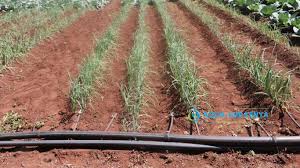
drip irrigation system installed for onion farming irrigation
Onions have shallow roots, so they require frequent irrigation for good yields and uniform bulb development.
Traditional irrigation often wastes water and nutrients as moisture moves below the active root zone.
Because onion leaves are prone to foliar diseases that thrive in wet conditions, sprinkler systems can increase disease risk by wetting the entire canopy. Drip irrigation avoids this by keeping foliage dry while providing consistent moisture to the root zone.
Onion Water Requirements
Onions require about 0.15 to 0.25 inches of water per day which is met when irrigation is done for after every 4 or 5 days.
The amount of water needed for proper growth of onions vary with the growth stage. At early growth stage, irrigation should be light but frequent to enhance faster growth. At the stage of bulb formation, the rate of irrigation needs to be high for proper bulb formation.
Components of a Drip Irrigation Kit for Onions
Complete drip irrigation kits for onions have the following components:
- Mainline and Sub-mainline HDPE Pipes – for water source to field connection.
- 1000m Dripline rolls – either 15, 20cm or 30 cm dripline rolls depending on crop type
- Water filter – disc or screen filter as per your system requirements.
- Ball control Valves – PVC ball corks for water flow control in farm sections.
- Connectors – drip valves, offtake and end plugs. HDPE tee, elbow, couplings, male and female adapter, and end caps.
- Fertilizer injector
- Tank connector – connection to the tank
- Gate valve – for control of water flow from the source.
- Storage tank – irrigation water storage tank.
Designing Drip Irrigation System for Onion Farming
Layout
Design of drip irrigation system for onion farming starts by deciding the layout to use. You can either choose to use raised beds or flat layout but mainly depends on the crops grown.
For onions, you will need to prepare raised beds for proper cultivation of the plant. Onion beds take 3 or 4 lines of driplines. Your driplines would be laid along the beds at a distance of 20 cm apart. The run length is often the size of the beds, normally 50
Ideal dripline for Onions
For onion plant, 15cm emitter spaced driplines work best but you can also use a 20 cm emitter dripline.
Pressure requirements
Drip irrigation with raised bed layout distributes water by gravity generated through raised water tank setup 3m high.
If you are not sourcing water from a raised water tank, you would need to a water pump and a pressure regulator. Pressure regulator regulates the pressure to a suitable level and prevents damage of the driplines.
Benefits of Drip Irrigation Systems for Onion Cultivation
- Water Efficiency: less water is utilized to grow onions because the direct delivery to roots prevents evaporation.
- Fertilizer management: onions receive fertilizers through drip irrigation kit, minimizing wastage.
- Quality bulb and high yield: onion plants get sufficient moisture during critical growth stages especially bulb formation. This enhances high yield and proper bulb size.
- Low disease risk: lower fungal infection cases because the method does not wet the leaves. Fusarium wilt is not a problem; we provide agronomy support for soil test before onion planting.
- Low labor cost: you don’t need labor to irrigate your onions once you have drip irrigation system set. You can automate it to water during dry periods in the morning or afternoon.
Installation Guide for Onion Drip Irrigation
- Prepare your water source: ensure you have a clean tank or well equipped with a filter.
- Lay your mainline and sub-mains: run HDPE pipes from the source across your field.
- Lay drip tape: roll out the drip lines along each bed or row, ensuring correct emitter spacing (e.g., 15–20 cm).
- Connect fittings and valves: use tees, end caps, and valve points for control zones.
- Install filter: before the water enters the drip lines, use a filter to avoid emitter clogging.
- Pressure regulation: Add a pressure regulator to maintain optimal pressure (10–20 psi) for drip lines.
- Flush the system: after setup, flush out the lines to clear dust or debris.
- Test for leaks: turn on the system and check for leaks or blockages, repair as needed.
Irrigation Scheduling Best Practices
Getting your irrigation scheduling right is crucial to maximizing both yield and water savings. For onions, schedule based on growth stage:
- Establishment phase: Light but frequent watering to maintain moisture in the root zone.
- Bulb formation: This is the most water-sensitive stage you might irrigate daily or every other day, depending on soil moisture.
- Maturity: As bulbs mature, you can reduce frequency slightly but ensure consistency to avoid stress.
Using soil moisture sensors or timers greatly helps you avoid guesswork. For example, many small farmers in Kenya use timers set for 30–40 minutes per session, 3–4 times per week.
Also, adjust your schedule based on weather. After heavy rain, skip or shorten irrigation. In hot, dry spells, you may need to increase frequency briefly.
How to Solve Challenges of Onion Drip Kits
- Emitter clogging: Without good filtration, emitters can get blocked by sand or debris.
- Pressure fluctuation: If pressure is too high or uneven, water distribution may be non-uniform.
- High upfront cost: Purchasing components and installation can be expensive, especially for small-scale farmers.
- Maintenance burden: Drip lines need periodic flushing, cleaning, and monitoring.
- Seasonal disconnection and reinstallation during farm preparation on the onset of new growing season.
How to Choose Drip Irrigation Kits for Onion farming
When choosing a drip irrigation kit for onion farming, keep these factors in mind:
- Emitter spacing: Make sure the kit offers appropriately spaced emitters (15 cm or 20 cm) for onions.
- Pressure rating and durability: The drip tape should survive the pressures you will operate (typically 10–20 psi) and resist UV damage.
- Parts availability: Ensure you can easily get spare parts (connectors, fittings, valves) locally.
- Technical support: A supplier who provides installation help or agronomic advice adds huge value.
Smart and Advanced Drip Irrigation systems
Smart irrigation system provides high performance and optimal irrigation for your onions.
- Automated controllers and timers: These let you schedule watering without manual input.
- IoT-based systems: Soil moisture sensors, remote control, and data logging help you optimize water use.
- sensor-based control: Emerging systems use multi-sensor fusion or visual feedback to manage irrigation, particularly for variable terrain.
Practical Drip Irrigation Tips for Onion Farming
- Irrigate in the early morning: This reduces evaporation and ensures water is available when plants need it most.
- Flush your lines regularly: At least once a month (or more if you have dirty water) to avoid clogging.
- Train your team: Make sure everyone understands valves, filters, and how to check for pressure or leakage.
- Plan for expansion: Lay your mainline and sub-mains in a way that makes adding more drip lines or beds easy.
- Monitor and adjust: Use soil moisture probes or even manual checks to adjust schedule as the season changes.
Get Started with Aqua Hub Drip Irrigation for Onion Farming
Ready to get started? Here’s what you should do next:
- Map your farm: Sketch out beds, rows, and water-source location to plan layout.
- Set a budget: Based on local supplier quotes, decide how many drip lines per bed you can afford.
- Find a supplier: Contact trusted local companies (like in Kenya) for a farm-specific kit.
- Install and train: Either self-install or use training from the supplier; get familiar with routine maintenance.
- Monitor performance: Track water use, check for blockages, and adjust your schedule based on plant growth.
- Measure impact: After a season, measure yield, water use, and cost benefit to decide on expansion.
Takeaways
- Drip irrigation targets water directly to the onion’s root zone, improving efficiency and reducing disease risk.
- Proper design (emitter spacing and pressure) is critical for good performance.
- Cost is high initially, but water savings, higher yields, and fertigation make it cost-effective over time.
- Maintenance such as flushing, filter cleaning, and pressure checks is key to long-term success.
- Smart drip systems (with sensors or IoT) can further improve water management and reduce labour.
Frequently Asked Questions
How much does a drip irrigation kit for onions cost?
A typical 1-acre drip kit in Kenya ranges from KES 130,000 to KES 170,000, depending on number of drip lines and components.
What emitter spacing is best for onion drip tape?
For onions, emitter spacing of 15–20 cm is common, ensuring each plant gets enough water.
How often should I irrigate my onions with drip?
It depends on growth stage: early stages require frequent, light irrigation; during bulb formation, you may irrigate daily or every other day.
Can I apply fertilizer through drip irrigation (fertigation)?
Yes. using a fertigation unit, you can inject soluble fertilizers directly into the irrigation water, optimizing nutrient delivery.
Will drip irrigation reduce fungal disease on onions?
Yes. because drip keeps foliage dry, it significantly reduces the risk of fungal infections that thrive on wet leaves.
What maintenance does a drip system need?
Regular tasks include flushing lines, cleaning filters, checking pressure, and repairing leaks or damaged tape.
Can I save water with drip compared to furrow irrigation?
Yes. Drip kits can reduce water use by up to 40–50% compared to traditional methods.
What are the common challenges with drip systems?
Some risks include emitter clogging, pressure issues, high initial cost, and regular maintenance needs.
Are there automated or “smart” drip systems for onions?
Absolutely you can use timers, soil moisture sensors, or even IoT-based systems to optimize watering.
Where can I buy a drip irrigation kit for onions?
Aqua Hub LTD.



